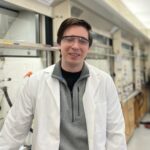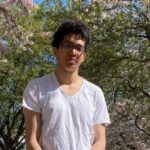‘Researcher Highlight’
Researcher Highlight: Andrey Shults
Jan. 24, 2024—Andrey Shults, 4th year Chemistry PhD Candidate in the Macdonald Lab. Summary of Research: My research focuses on the synthesis of various metal chalcogenide nanoparticles and the mechanistic understanding of their formation. Just as with graphite and diamond, the polymorphs of carbon, the two different elements of a metal chalcogenide can combine in different ratios...
Researcher Highlight: Laura Bertolami
Jan. 24, 2024—Laura Bertolami, a senior undergraduate Chemical Engineering student on Senior Tech Crew. I have been working on the tech crew since May 2022, and have been senior tech crew since October 2023. My current project involves developing parameters for multiple aperture patterning with Electron Beam Lithography as well as developing standards for available feature sizes...
Researcher Highlight: Owen Meilander
Jan. 23, 2024—Owen Meilander, 2nd year Interdisciplinary Material Science PhD student in Dr. Mona Ebrish’s Lab in the Electrical Engineering department. Summary of Research: My work focuses on the fabrication and characterization of gallium nitride (GaN) semiconductor devices. GaN devices offer many benefits for high power and high frequency applications. It will allow for more efficient...
Researcher Highlight: Boyang Xiao
Jan. 22, 2024—Boyang Xiao, 2nd year PhD student under the supervision of Prof. Xiaoguang Dong in Mechanical Engineering. Gastrointestinal (GI) diseases have become more common and serious among health problems in the US. It is reported that there are over twenty million Americans suffering from chronic GI diseases. How to provide timely diagnosis, long-term monitoring, and effective...
Researcher Highlight: Emily Fabiano
Jan. 22, 2024—Emily Fabiano, 3rd year Biomedical Engineering PhD student in the Reinhart-King Lab Research Summary: My research focuses on understanding the intersection of cell migration and bioenergetics in breast cancer. Specifically, I investigate the role that cell-matrix adhesions play in regulating bioenergetics, aiding in more efficient cancer cell migration that enables cancer cells to metastasize. Upon...
Researcher Highlight: Payton Stone
Jan. 22, 2024—Payton Stone, 4th year Chemical Engineering Ph.D. Candidate in the Wilson Lab Summary of Research: Peptides, proteins, and nucleic acids make up many of the recently developed cancer immunotherapies, which function by activating intracellular pathways to elicit downstream signaling cascades, which in turn result in robust anticancer immune responses. However, the clinical success and efficacy...
Researcher Highlight: Chloe Frame
Oct. 9, 2023—Chloe Frame, 5th year Chemical Engineering PhD Candidate in the McCabe Lab Summary of Research: My work focuses on the outermost layer of the epidermis, the stratum corneum, which consists of corneocytes (dead skin cells) embedded in highly organized lipid lamellae. This lipid matrix is responsible for the barrier function of skin and one of...
Researcher Highlight: Jason Valentine
Oct. 6, 2023—Jason Valentine, Professor of Mechanical Engineering (primary) and Electrical Engineering; Deputy Director, Vanderbilt Institute of Nanoscale Science and Engineering Advances in optical materials and technologies have been a key enabler of the information age. Conventional free-space optical elements such as lenses, beam splitters, and polarization optics have, however, remained relatively unchanged over the course of...
Researcher Highlight: Craig Duvall
Oct. 5, 2023—Craig Duvall, Cornelius Vanderbilt Professor, Department of Biomedical Engineering; Professor, Ophthalmology and Visual Sciences; Professor, Chemical and Biomolecular Engineering The central dogma of biology is that genomic DNA encodes for messenger RNA (mRNA), which is then translated into proteins. Proteins are the fundamental units that drive the functions of cells and tissues in the body,...
Researcher Highlight: Geordan Dorsey
Oct. 5, 2023—Geordan Dorsey, a Fisk physics graduate student who uses VINSE facilities to take measurements. Gallium Oxide has been of particular interest in the last few decades due to its outstanding optoelectronic properties. The most important of these is its ultra-wide band gap of 4.8 eV, making it an attractive semiconductor for applications in solar-blind UV...








